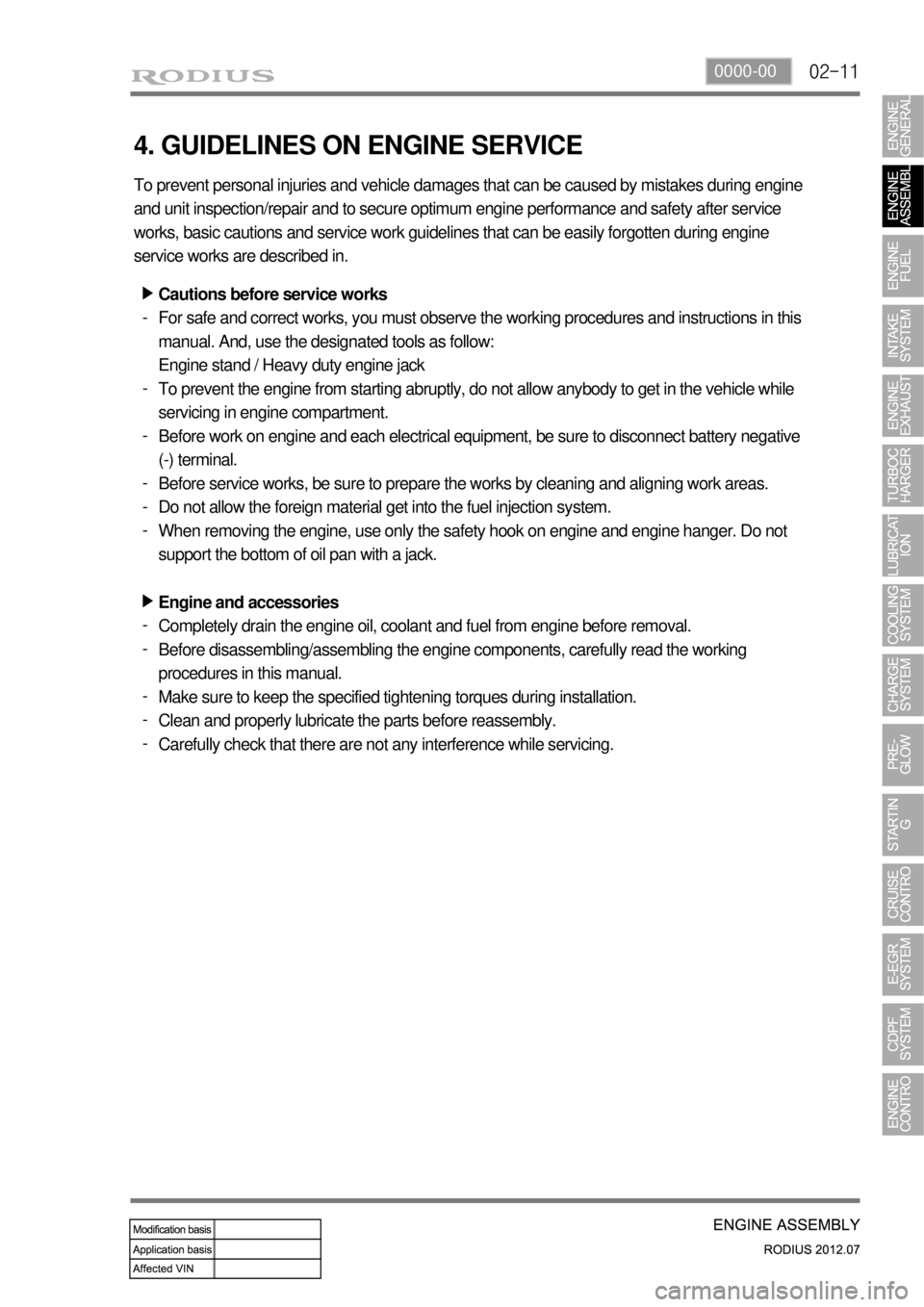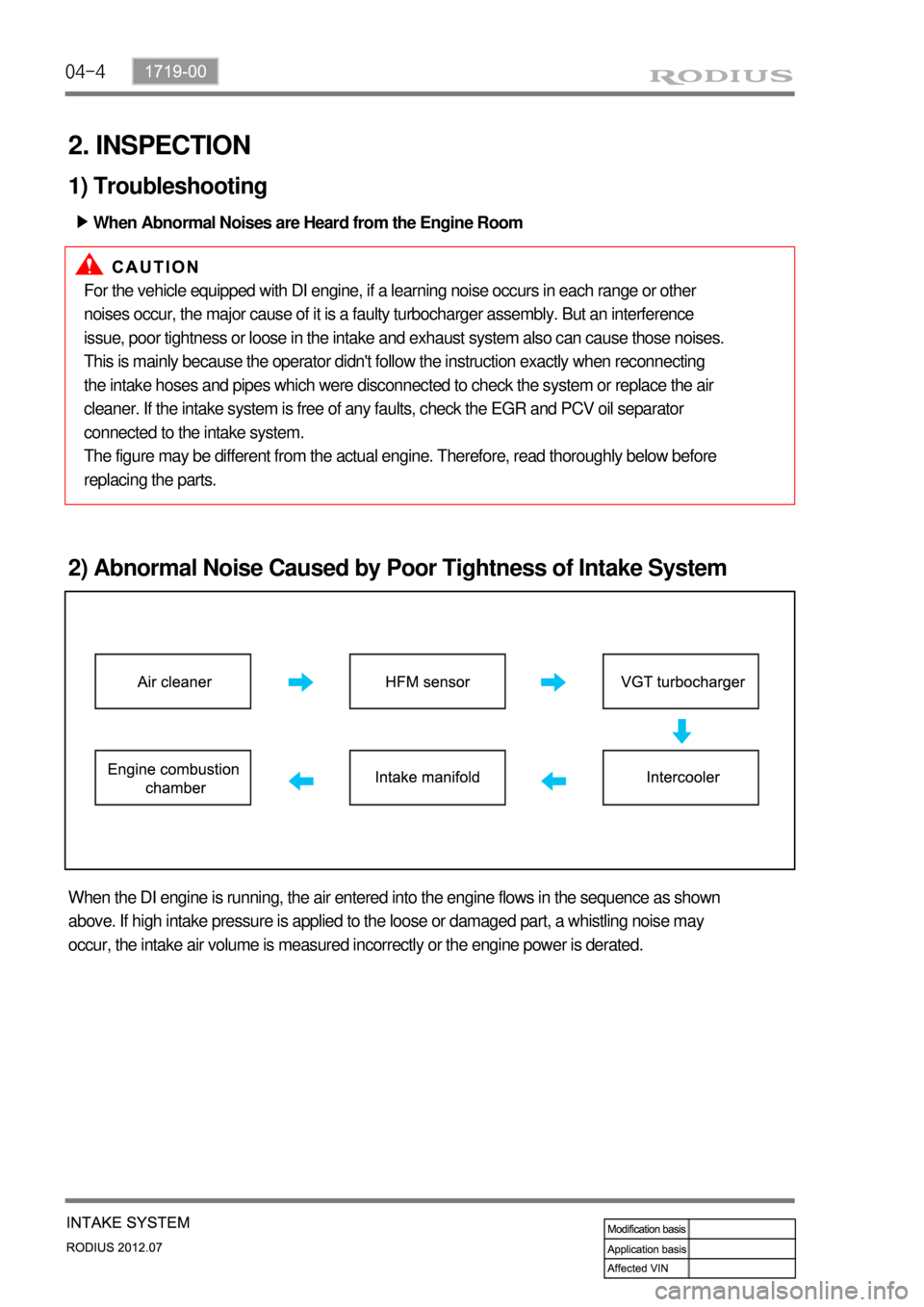2012 SSANGYONG RODIUS check oil
[x] Cancel search: check oilPage 148 of 715

01-6
3. ENGINE COMPARTMENT LAYOUT
Do not work on the engine compartment while the engine, radiator, exhaust manifold, muffler
or catalytic converter is hot. Always turn the engine off and allow it to cool before starting the
maintenance.
Regularly check the engine oil level and add Ssangyong genuine engine oil if necessary.
Clean the dipstick with clean cloth so that any foreign materials cannot get into the engine. -
-
-
Power steering fluid
reservoir Brake fluid reservoir
Engine oil
dipstick gauge
Washer fluid
reservoir cap Engine oil filler cap
Air cleaner
Operating vehicle with insuffi cient amount of oil can damage the engine. Make sure the
engine oil level is correct and add oil if necessary.
Coolant reservoir
Battery
Fuse & relay
Page 168 of 715

02-110000-00
4. GUIDELINES ON ENGINE SERVICE
To prevent personal injuries and vehicle damages that can be caused by mistakes during engine
and unit inspection/repair and to secure optimum engine performance and safety after service
works, basic cautions and service work guidelines that can be easily forgotten during engine
service works are described in.
Cautions before service works
For safe and correct works, you must observe the working procedures and instructions in this
manual. And, use the designated tools as follow:
Engine stand / Heavy duty engine jack
To prevent the engine from starting abruptly, do not allow anybody to get in the vehicle while
servicing in engine compartment.
Before work on engine and each electrical equipment, be sure to disconnect battery negative
(-) terminal.
Before service works, be sure to prepare the works by cleaning and aligning work areas.
Do not allow the foreign material get into the fuel injection system.
When removing the engine, use only the safety hook on engine and engine hanger. Do not
support the bottom of oil pan with a jack.
Engine and accessories
Completely drain the engine oil, coolant and fuel from engine before removal.
Before disassembling/assembling the engine components, carefully read the working
procedures in this manual.
Make sure to keep the specified tightening torques during installation.
Clean and properly lubricate the parts before reassembly.
Carefully check that there are not any interference while servicing. ▶
-
-
-
-
-
-
▶
-
-
-
-
-
Page 169 of 715

02-12
Electrical equipment ▶
Electric devices should be handled more carefully.
Currently, the engine has a lot of electric devices. there could be poor engine performance,
incomplete combustion and other abnormal symptoms due to short circuit or poor contact.
Before work on engine and each electrical equipment, be sure to disconnect battery negative
(-) terminal.
When replacing the electric device, use only genuine part and check the conditions of
connections and grounds. Loosened connection or ground make cause a fire and personal
injury. -
-Fuel and lubrication system ▶
Do not allow the fluid and engine oil to make contact with the body paintwork and hoses.
If work on the fluid system such as fuel and oil, working area should be well ventilated and
smoking should be prohibited.
Gasket or seal on the fuel/lubrication system should be replaced with new ones and bolts and
nuts should be tightened as specified.
After removal/installation works, be sure to check whether there is leak on the connecting
section. -
-
-
-
If fine dust or foreign material enters into DI engine's fuel system, there can be serious damages
in HP pump and injectors. Thus, be sure to plug the inlets of removed fuel line components with
cap and protect removed parts not to be contaminated with dirt. (Refer to cleanness in this
manual while working on DI engine fuel system)
Page 187 of 715

02-30
(2) Layout
Chain upper bush
Type: single bush
Chains:112 EA
Tensioner rail
Installed between exhaust
Camshaft sprocket and
crankshaft sprocket
Hydraulic tensioner
Contains tensioner housing
plug, spring and check valve,
and operated by hydraulic
pressure
Crankshaft sprocket
Teeth: 21 EA
Oil pump sprocket
Teeth: 33 EA
Chain lower bush
Chain type: single bush
Chains: 60 EA
Mechanical type tensioner
Operated by internal spring
Clamping rail
Installed between exhaust
Camshaft sprocket and
crankshaft sprocket
Exhaust camshaft
sprocket
Teeth: 42 EA
The brass links on timing chain are aligned with the timing marks on crankshaft sprocket and
camshaft sprocket by eight turns of crankshaft.
Page 224 of 715

03-20
Water
separator
(2) Di engine and its expected problems and remedies can be caused by
water in fuel
System supplement against paraffin separation ▶
In case of Diesel fuel, paraffin, one of the elements, can be separated from fuel during winter and
then can stick on the fuel filter blocking fuel flow and causing difficult starting finally. Oil
companies supply summer fuel and winter fuel by differentiating mixing ratio of kerosene and
other elements by region and season. However, above phenomenon can be happened if stations
have poor facilities or sell improper fuel for the season. In case of DI engine, purity of fuel is very
important factor to keep internal preciseness of HP pump and injector.
Accordingly, more dense mesh than conventional fuel filter is used. To prevent fuel filter internal
clogging due to paraffin separation, SYMC is using fuel line that high pressure and temperature
fuel injected by injector returns through fuel filter to have an effect of built-in heater (see fuel
system).
System supplement and remedy against water in fuel ▶
As mentioned above, some gas stations supply fuel with excessive than specified water. In the
conventional IDI engine, excessive water in the fuel only causes dropping engine power or engine
hunting. However, fuel system in the DI engine consists of precise components so water in the
fuel can cause malfunctions of HP pump due to poor lubrication of pump caused by poor coating
film during high speed pumping and bacterization (under long period parking). To prevent
problems can be caused by excessive water in fuel, water separator is installed inside of fuel
filter. When fuel is passing filter, water that has relatively bigger specific gravity is accumulated on
the bottom of the filter.
Water drain from water separator ▶
If water in the separator on the fuel filter exceeds a certain level, it will be supplied to HP pump
with fuel, so the engine ECU turns on warning lamp on the meter cluster and buzzer if water level
is higher than a certain level.
Due to engine layout, a customer cannot easily drain water from fuel filter directly, so if a
customer checks in to change engine oil, be sure to perform water drain from fuel filter.
To separate the water from the fuel filter,
remove the fuel filter assembly first.
Page 232 of 715

04-4
2. INSPECTION
1) Troubleshooting
When Abnormal Noises are Heard from the Engine Room ▶
For the vehicle equipped with DI engine, if a learning noise occurs in each range or other
noises occur, the major cause of it is a faulty turbocharger assembly. But an interference
issue, poor tightness or loose in the intake and exhaust system also can cause those noises.
This is mainly because the operator didn't follow the instruction exactly when reconnecting
the intake hoses and pipes which were disconnected to check the system or replace the air
cleaner. If the intake system is free of any faults, check the EGR and PCV oil separator
connected to the intake system.
The figure may be different from the actual engine. Therefore, read thoroughly below before
replacing the parts.
2) Abnormal Noise Caused by Poor Tightness of Intake System
When the DI engine is running, the air entered into the engine flows in the sequence as shown
above. If high intake pressure is applied to the loose or damaged part, a whistling noise may
occur, the intake air volume is measured incorrectly or the engine power is derated.
Page 233 of 715

04-51719-00
3) Troubleshooting Sequence
The basic checks for intake system are as follows:
Basic Checks for Intake System ▶
Make sure to replace or clean the air cleaner
element periodically. Otherwise, engine will be
derated or work abnormally because of low
intake air volume.
Unlike the fuel system, which is a closed
circuit, the intake system is an open circuit
system. Therefore any malfunction may occur
due to dust and dirt.
Most of the connections consist of hoses so
the system cannot withstand high temperature
and pressure. Also it can be deformed or
loosened easily because it is a clamp
mounting system. Thus, when checking the
engine, basic inspections, such as tightened
status check and visual inspection for hose,
etc., should be carried out in advance.
Other Checks for Intake System ▶
If the intake system is free of any faults,
check for EGR and PCV oil separator.
Page 245 of 715

06-4
2. INSPECTION
1) Cautions During Driving
The following lists cautions to take during test drive and on the turbocharger vehicle, which must
be considered during the operation.
It's important not to drastically increase the engine rpm starting the engine. It could make
rotation at excessive speed even before the journal bearing is lubricated and when the
turbocharger rotates in poor oil supply condition, it could cause damage of bearing seizure
within few seconds.
If the engine is running radically after replacing the engine oil or oil filter brings poor oil supply
condition. To avoid this, it's necessary to start off after idling the engine for about 1 minute
allowing oil to circulate to the turbocharger after the replacement.
When the engine is stopped abruptly after driving at high speed, the turbocharger continues to
rotate in condition where the oil pressure is at '0'. In such condition, an oil film between the
journal bearing and the housing shaft journal section gets broken and this causes abrasion of
the journal bearing due to the rapid contact. The repeat of such condition significantly reduces
life of the turbocharger.
Therefore, the engine should be stopped possibly in the idle condition. 1.
2.
3.
After string for long period of time during winter season or in the low temperature condition
where the fluidity of engine oil declines, the engine, before being started, should be cranked
to circulate oil and must drive after checking the oil pressure is in normal condition by idling
the engine for few minutes.